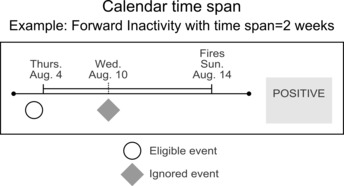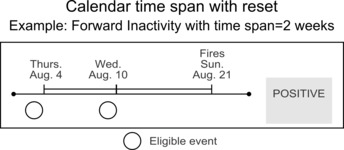Calendar time span in Forward Inactivity components
You can set either a calendar or rolling time span in Forward Inactivity components.
For both calendar and rolling time spans, the incoming event timestamp is used as the starting point of the time span.
Calendar time span
In the example diagram, a Forward Inactivity component has a time span of two calendar weeks, and the component is activated by an event with a timestamp of Thursday, August 4. No canceling event is specified.
The first week of this calendar time span ends at midnight on Sunday, August 7, only three days later. When the second week ends at midnight on Sunday, August 14, the time span expires and the component fires. This is because a week as defined by the time constant always begins at midnight on Sunday.
The component in the example ignores any additional incoming events because reset is not enabled.

Calendar time span with reset
If reset is enabled, the component continues to listen for incoming events even after it is activated.
In the example diagram, a Forward Inactivity has a calendar time span of two weeks, and the component is activated by an event with a timestamp of Thursday, August 4. No canceling event is specified.
With reset enabled, the component would reset its time span if a second incoming event arrives with a timestamp that falls within the time span. Suppose this timestamp is Wednesday, August 10. The time span resets, and the first week ends at midnight on Sunday, August 14, only four days later. When the second week ends at midnight on Sunday, August 21, the time span expires and the component fires.

